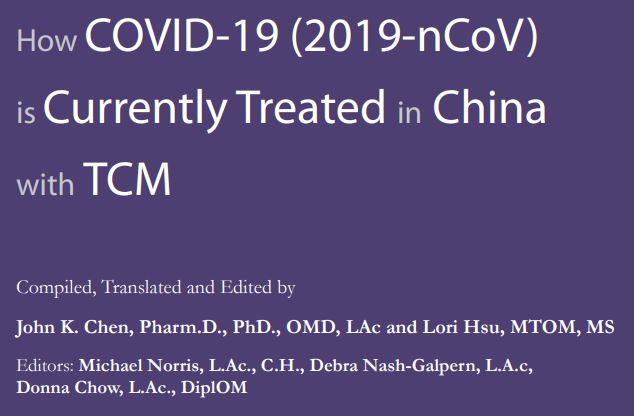
Prevention Phase: 预防期
Acupuncture Treatment for Suspected Cases:
The purpose is to strengthen the immune system, to help alleviate early symptoms, and to shorten the duration of the virus.
Points:
Bilateral Zusanli (ST36), Qihai (CV6), Zhongwan (CV12)
족삼리 https://www.kmcric.com/database/acupoint/ST/ST36
기해 https://www.kmcric.com/database/acupoint/CV/CV6
중완 https://www.kmcric.com/database/acupoint/CV/CV12
Method and Frequency:
• Moxa Zusanli (ST36) on both sides for 15 minutes. Moxa Qihai (CV6) or Zhongwan (CV12) for 10 minutes. (alternating from treatment to treatment).
• Twice a day, once in the afternoon and once at night.
Influenza Phase: 流感期
1.
Wind-Cold Invading the Exterior 风寒袭表证 Clinical Manifestations:
Onset of fever (mostly low-grade fever), aversion to cold and fear of cold, chills, headache, ticklish throat, soreness of muscles of limbs, no sweat or night sweats.
Examination:
Lung CT negative. Tongue is pale, coating is white and thin. Floating pulse.
Treatment Strategy:
Expel Wind, Release the Exterior; Clear Heat, Detoxify
2.
Toxic Heat Attacking the Lung 热毒袭肺证 Clinical Manifestations:
Fever, aversion to cold, sore and dry throat, dry cough, scanty sputum, sore and painful muscles in the limbs, weakness, headache.
Examination:
CT scan reveals both lungs to have scattered ground-glass opacity (GGO). Tip and sides of the tongue are red; thin white or yellow tongue coating. Floating and rapid pulse.
Treatment Strategy:
Expel Wind, Release the Exterior; Clear Heat, Detoxify
3.
Damp Cold in the Lung 濕寒鬱肺 Clinical Manifestations:
Aversion to cold, fever or absence of fever, dry cough, dry throat, fatigue, weakness, chest stuffiness, epigastric distention, nausea, diarrhea. Pale tongue, white greasy coating, slippery pulse.
Treatment Strategy:
Expel Wind, Release the Exterior; Dispel Damp Cold
Acupuncture Treatment for Mild and Moderate Cases:
The purpose is to reduce the severity of symptoms, shorten the duration, and alleviate emotional burden.
Points:
Bilateral Hegu (LI4), Taichong (LR3), Zusanli (ST36), Shenque (CV8)
합곡 https://www.kmcric.com/database/acupoint/LI/LI4
태충 https://www.kmcric.com/database/acupoint/LR/LR3
족삼리 https://www.kmcric.com/database/acupoint/ST/ST36
신궐 https://www.kmcric.com/database/acupoint/CV/CV8
Method and Frequency:
• Moxa Hegu (LI4) and Taichong (LR3) bilaterally for 15 minutes. Moxa Zusanli (ST36) bilaterally for 10 minutes. Moxa Shenque (CV8) with a moxa box for 15 minutes.
• Twice a day, once in the morning and once in the afternoon.
Recovery Phase: 恢复期
Clinical Manifestations:
Absence of fever, dry cough, chest stuffiness, shortness of breath, shortness of breath upon exertion, dry mouth, weakness.
Examination:
CT reveals inflammation begins to subside as well as pulmonary interstitial changes. Pale red tongue, thick or greasy coating, thread, rapid pulse.
Treatment Strategy:
Tonify Qi, Nourish Yin, Tonify Lung and Open the Collaterals
Acupuncture Treatment for The Recovery Phase:
The Purpose is restore Lung and Spleen functions and the body’s zheng (upright) qi.
Points:
Bilateral Dazhui (GV14), Geshu (BL17), Feishu (BL13), Zusanli ( ST36) or Kongzui (LU6).
대추 https://www.kmcric.com/database/acupoint/GV/GV14
격수 https://www.kmcric.com/database/acupoint/BL/BL17
폐수 https://www.kmcric.com/database/acupoint/BL/BL13
족삼리 https://www.kmcric.com/database/acupoint/ST/ST36
공최 https://www.kmcric.com/database/acupoint/LU/LU6
Method and Frequency:
• Moxa all points for 15 minutes.
• Once a day.
References
[1] 新型冠状病毒感染肺炎诊疗方案(第四版). 1月28日
https://mp.weixin.qq.com/s/qzSecLwVXQIfFBTQyHQxHQ
[2] 8个防治肺炎的中医药协定方. 湖北省中医院. 1月31日
https://mp.weixin.qq.com/s/YajZ_fycSKEoTBvzhOv5Wg
[3] 《新型冠状病毒肺炎针灸干预的指导意见(第一版)》. 中国针灸学会. 2月9日
https://mp.weixin.qq.com/s/qSUM5kYJIPJTvKkf_HfuaA
출처: 2020 Lotus Institute of Integrative Medicine
